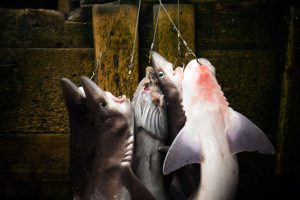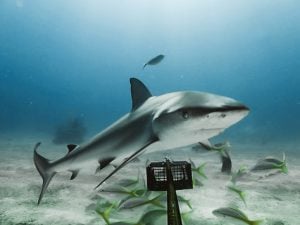
Wildlife
The great green shark hunt
Can British Columbia’s spiny dogfish make the grade as the world’s first “sustainable” shark fishery?
- 3319 words
- 14 minutes
Wildlife
Under Canadian leadership, the landing ban means more sharks will survive accidental capture — but is it enough?

Built for speed with a body shaped like a bullet, the shortfin mako shark is the fastest shark in the ocean — and a well-known apex predator. Often seen jumping to extreme heights and reaching speeds of 74 kilometres per hour, this incredible shark can be found throughout the northern Atlantic Ocean, including off Canada’s east coast. But despite being top of the oceanic food chain, they can’t out-swim the grasp of fishnets.
Classified as endangered by the Committee on the Status of Endangered Wildlife in Canada (COSEWIC) in 2019, the most prominent threat to the shortfin mako shark is ending up as bycatch. In the open ocean, makos live freely amongst swordfish and yellow tuna while hunting squid and bony fish like mackerel. But these sharks frequently end up in the gillnets or longlines of commercial fishing boats as incidental catches.
Compared to other sharks, makos have a slow growth rate — females only give birth to between four to 18 pups every three years — making them extremely vulnerable to overfishing.
“Unlike something like tuna or swordfish, makos are a species that can’t replace its population very fast,” says Micheal Byrne, an assistant professor of wildlife ecology at the School of Natural Resources – University of Missouri. “They’re an animal that can’t really handle a lot of pressure.”
Over the years, Canada’s population of mako sharks has continued to decline, and researchers have been examining the impacts of overfishing on this species. In 2017, Byrne and colleagues published a study that tracked 40 mako sharks using satellite tagging over three years. Of the sharks that were tracked, almost a third were harvested, suggesting the wider population was being overexploited. Byrne says there was a need to reduce the number of sharks taken from the water by finding a way to minimize the incentive to land the species.
To combat this decline, the Department of Fisheries and Oceans Canada enacted a landing ban in 2020 which required all makos to be released from nets, dead or alive. “It used to be that you had to release a shark that was captured alive,” says Byrne. “But now, even if the shark comes to the boat dead, you’re not allowed to take it.” In 2022, under Canadian leadership, the ban was adopted temporarily by other nations, such as the United States and Spain, which also belong to the International Commission on the Conservation of Atlantic Tunas (ICCAT). As an inter-governmental fishery organization, ICCAT is responsible for the conservation of tunas and tuna-like species in the Atlantic Ocean and nearby seas. Sharks represent a significant component of ICCAT fisheries and rank among the most commonly captured species in the organization.
But even with the ban in place, Byrne says this won’t reduce fisheries-caused mortality to zero. “There’s going to be some level of sharks that are captured by accident and some level of those sharks are going to die even if they’re released, just because they get injured or worn out on the line,” says Byrne. “The idea is to minimize mortality as much as possible and that’s what the ban is trying to do.”

Dead or alive, a caught mako shark must be recorded under the landing ban. But “sometimes when sharks come up, they’re not moving,” says Heather Bowlby, research lead at the Canadian Atlantic Shark Research Laboratory. She says this can make it difficult to classify whether a shark is dead or alive. “They’re just spiralling through the water column. They may look a little beat up or they might look fine.” With the landing ban in place, any subjectivity is removed and there is reduced potential for misclassification.
“Although not directly the target of the ban, people could still derive value from them in terms of being able to sell them,” says Bowlby. She explains that, now that sharks can’t be landed at all, it can cost fishermen money when sharks need to be cut off gear. Hooks and lines can also be wasted.
“There’s actually a very slight negative incentive to catch those animals, which we’re hoping will actually lead to spatial-temporal management by the fleet,” Bowlby says. “If they’re catching a lot of sharks, it’s very likely they’ll move to another area so that they’re not both wasting their time or losing gear.”
Released in May 2022, an assessment report led by Bowlby looks at the recovery potential of shortfin mako sharks in the North Atlantic. Using an at-sea observer program, researchers looked at the scope of animals that were recorded as dead at-vessel to understand the proportions of dead vs. alive sharks. Bowlby says that between 2010 and 2017, 20 to 30 per cent of sharks were recorded as being dead once at-vessel. After the first year of the landing ban, this number jumped to half and then to just under 70 per cent the following year. She says that the assumption that sharks were being recorded incorrectly could be inferred by the very notable increase of sharks that were now being recorded as dead.
The report also assessed how many mako sharks were caught in the North Atlantic over time. Since 1994, annual catches of shortfin mako averaged 3,685 tonnes with an average of 67 tonnes per year coming from Canada. Within the country, the majority of landings come from fisheries in the Maritimes with minimal contributions from Quebec and Gulf regions, the report states. In the early 2000s, landings of mako sharks were around 70 tonnes but this decreased to approximately 32 tonnes in 2012. However, in recent years, this number has fluctuated, with a decrease between 2018 and 2019, partially related to a change in license conditions which mandated the release of all live captures. With the new landing ban in place, even sharks that are dead at-vessel must still be released.
Prior to the ban, Bowlby says there was no incentive to avoid catching mako sharks, as fisheries could still derive value from them. Since the ban has been put in place, it’s become more of a nuisance to catch a shark by accident.
To reduce mako mortality further, Bowlby says work would have to focus on minimizing the potential for interaction with fishing boats, so the possibility that fisheries catch sharks at all is reduced. This can be done through practices like spatial-temporal management, i.e. changing where and when people fish to avoid interaction with the species.
The landing ban was implemented in mid-2022 and will remain in place until 2023, aiming to decrease the number of shortfin mako sharks landed by fisheries and encourage population growth. However, due to the slow development of makos, Byrne believes that two years is not enough. “It could be effective but it has to go on for years,” he says. “Two years really isn’t enough time to see a huge change.”
Bowlby explains that for Canada, the requirement is to submit data to ICCAT during July each year. Because of this, a full year’s worth of data on shark mortality won’t be available until much later. “We won’t actually know until 2024, at the earliest, what the drop in mortality has been,” she says. This is after when the ban will purportedly be lifted.
On whether the ban should be extended, Bowlby believes it will depend entirely on what scientific assessments state. “When we need the management, it should be there,” she says. “If we need different management, we should be able to adapt to that.”
In a few years, if no changes are observed and fishermen feel as though they’re losing a significant portion of their income by not being able to sell mako sharks, then Byrne says questions should be asked about the success of the ban. “It could be a model that moves forward,” says Byrne. “I just hope we can rebuild the population and get the fishing community on board and not demonize fishermen at the same time.”
Are you passionate about Canadian geography?
You can support Canadian Geographic in 3 ways:

Wildlife
Can British Columbia’s spiny dogfish make the grade as the world’s first “sustainable” shark fishery?

Environment
The planet is in the midst of drastic biodiversity loss that some experts think may be the next great species die-off. How did we get here and what can be done about it?

Wildlife
Lead author Aaron MacNeil discusses what this means for coral ecosystems and what Canadians can do to help

Wildlife
Korean-Canadian filmmaker Sonya Lee dives deep into the world of great white sharks for the latest documentary from CBC’s The Nature of Things